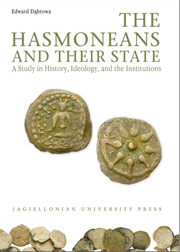Book contents
- Frontmatter
- Contents
- Introduction
- Abbreviations
- Part I Judea under the Hasmoneans (167–63 BCE)
- Part II The Institutions of the Hasmonean State
- I The Ruler
- 1 The Royal Priesthood or the Priestly Monarchy
- 2 The Priesthood
- 3 The Kingship
- 4 Succession
- 5 The Royal Family
- 6 The Court
- 7 The Capital City
- 8 The Palace and the Baris
- 9 Propaganda and Self-Presentation
- II The State
- Part III Society
- Conclusions
- Bibliography
- Index of Personal Names
- Index of Place Names
- Index of Ancient Sources
- Electrum - Volumes Published
- The Hasmonean State
1 - The Royal Priesthood or the Priestly Monarchy
from I - The Ruler
Published online by Cambridge University Press: 05 September 2014
- Frontmatter
- Contents
- Introduction
- Abbreviations
- Part I Judea under the Hasmoneans (167–63 BCE)
- Part II The Institutions of the Hasmonean State
- I The Ruler
- 1 The Royal Priesthood or the Priestly Monarchy
- 2 The Priesthood
- 3 The Kingship
- 4 Succession
- 5 The Royal Family
- 6 The Court
- 7 The Capital City
- 8 The Palace and the Baris
- 9 Propaganda and Self-Presentation
- II The State
- Part III Society
- Conclusions
- Bibliography
- Index of Personal Names
- Index of Place Names
- Index of Ancient Sources
- Electrum - Volumes Published
- The Hasmonean State
Summary
An attempt to outline the political system created by the Hasmoneans first requires its definition, for it was not a copy of any preexisting form of government. As an essential characteristic, it was a combination, a fusion of two entirely different elements which, in Israel's biblical history, made for two distinct qualities: religious authority and secular power. Successive Hasmoneans, as high priests of the Jerusalem temple, held the highest spiritual office, while at the same time they were the political heads of a state that would eventually take the form of monarchy. D.W. Rooke analyzed all records pertaining to the execution of the high priesthood by the Hasmoneans and concluded that in the system of government they created the secular element heavily outweighed the religious. In her opinion, it was a monarchy disguised as priesthood, what she calls “the sacred kings or the royal priesthood.” The foundations for the system were laid during the leadership of Jonathan and Simon, to remain largely unchanged in the later period. This is not to question the validity or accuracy of this opinion, but is seems that the high priesthood, at least formally, had far greater significance to the Hasmoneans than D.W. Rooke is prepared to ascribe to it. In our belief, this particular circumstance makes it more appropriate to describe the political system they created as a priestly monarchy.
- Type
- Chapter
- Information
- The Hasmoneans and their StateA Study in History, Ideology, and the Institutions, pp. 106Publisher: Jagiellonian University PressPrint publication year: 2009



